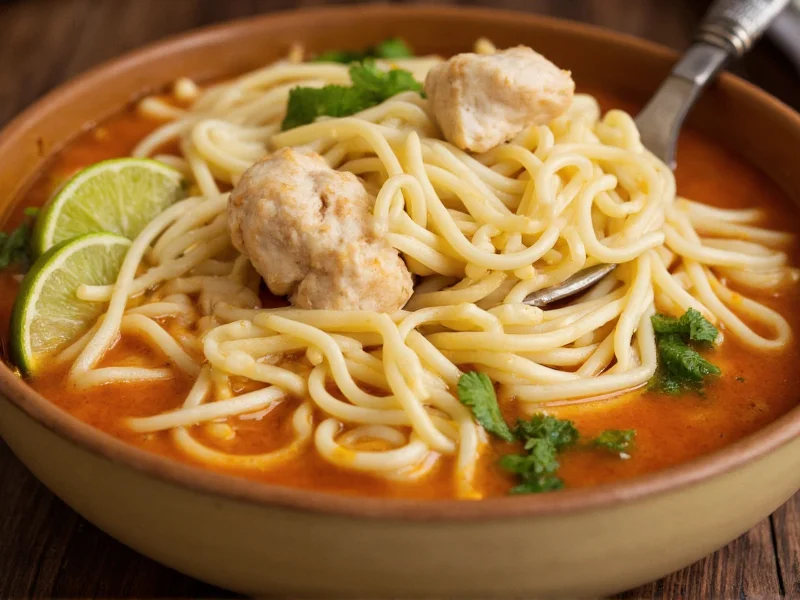When crafting the perfect chicken noodle soup, noodle selection is just as crucial as your broth quality. The right noodles enhance texture and flavor without compromising the soup's integrity. Many home cooks make the mistake of using inappropriate pasta types that either disintegrate or become unpleasantly gummy during cooking.
Why Noodle Choice Matters in Chicken Soup
The ideal chicken noodle soup noodle must withstand prolonged simmering while maintaining its structure. Unlike pasta dishes where al dente texture is desirable, soup noodles need slightly more durability to survive both cooking and storage. When noodles break down excessively, they release starch that thickens the broth unnaturally and creates a cloudy appearance.
Top Noodle Options for Chicken Noodle Soup
While personal preference plays a role, certain noodles consistently deliver superior results in traditional chicken noodle soup:
| Noodle Type | Width | Texture in Soup | Best For |
|---|---|---|---|
| Egg noodles (dried) | 1/8"-1/4" | Firm yet tender | Traditional recipes |
| Extra wide egg noodles | 1/2"+ | Substantial bite | Hearty soups |
| Homemade egg noodles | Customizable | Delicate texture | Fresh preparation |
| Orzo | Rice-sized | Small and uniform | Thickened broths |
Egg Noodles: The Traditional Choice
Dried egg noodles remain the gold standard for chicken noodle soup for good reason. Their egg content provides a subtle richness that complements chicken broth beautifully. Unlike regular pasta which uses only wheat and water, the egg proteins help maintain structure during cooking. Look for "medium" or "wide" varieties depending on your texture preference.
When selecting store-bought noodles for chicken noodle soup, check the ingredient list. High-quality options contain just flour, eggs, and salt. Avoid noodles with added preservatives or excessive starch, which can negatively affect your soup's clarity and texture.
Fresh vs. Dried Noodles: What Works Best
Many home cooks wonder whether fresh or dried noodles work better for chicken noodle soup. Dried egg noodles consistently outperform fresh pasta in soup applications. Fresh pasta, while delicious in standalone dishes, tends to overcook quickly in simmering broth, becoming unpleasantly soft within minutes.
Dried noodles have undergone a dehydration process that makes them more resilient to prolonged liquid exposure. This doesn't mean you can't use fresh noodles—they just require careful timing. If using fresh pasta, add it during the last 2-3 minutes of cooking and serve immediately.
Homemade Noodle Options
For those who enjoy from-scratch cooking, homemade egg noodles offer superior flavor and texture control. A simple recipe requires just flour, eggs, salt, and water. Roll the dough thin (about 1/16 inch) and cut into 1/8-inch strips for traditional chicken noodle soup.
Homemade noodles should be cooked separately and added to the soup just before serving. This prevents excess starch from clouding your broth. Fresh noodles will continue cooking in hot soup, so slightly undercook them when boiling.
Troubleshooting Common Noodle Problems
Even with the right noodles, issues can arise. Here's how to solve common problems when using noodles in chicken soup:
- Noodles becoming mushy: Cook noodles separately and add to individual bowls. This technique, used by professional kitchens, prevents overcooking during storage.
- Broth becoming cloudy: Rinse cooked noodles briefly in hot water before adding to soup to remove surface starch.
- Noodles absorbing too much broth: Underfill bowls with broth, as noodles will continue absorbing liquid while sitting.
- Uneven noodle texture: Cut noodles to uniform lengths for consistent cooking.
Storage and Reheating Tips
Proper storage makes all the difference in maintaining noodle quality. Store chicken noodle soup with noodles separately from the broth whenever possible. If already combined, expect noodles to continue softening during refrigeration.
When reheating soup with noodles, add a splash of water or additional broth to compensate for liquid absorption. Gently warm rather than boiling to prevent further breakdown of the noodles. For best results with store-bought noodles for chicken noodle soup, consume within 2-3 days of preparation.
Regional Variations Worth Exploring
While egg noodles dominate American-style chicken noodle soup, various cultures have their own interpretations. German Hühnernudelsuppe often uses thin spaetzle, while Jewish penicillin (matzo ball soup) features matzo balls instead of noodles. Asian-inspired versions might incorporate rice noodles or udon, though these create a distinctly different soup profile.
For authentic chicken noodle soup noodles as found in most American households, stick with medium-width dried egg noodles. Their balanced texture and flavor compatibility make them the ideal choice for this comfort food classic.











 浙公网安备
33010002000092号
浙公网安备
33010002000092号 浙B2-20120091-4
浙B2-20120091-4